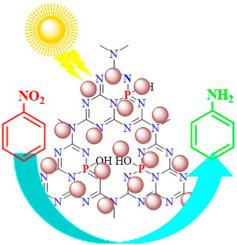Visible light mediated photocatalytic conversion of nitroaromatics to aminoaromatics employing a P doped g-C3N4/CuFe2O4 nanocomposite
IF 3.5
3区 化学
Q2 CHEMISTRY, INORGANIC & NUCLEAR
引用次数: 0
Abstract
This study reports the successful preparation of P-doped g-C3N4/CuFe2O4 nanocomposites using a co-precipitation method. The P-doped g-C3N4 material was synthesized through thermal calcination of melamine and diammonium hydrogen phosphate precursors, which allowed the effective incorporation of phosphorus atoms into the g-C3N4 structure. Afterwards, CuFe2O4 nanoparticles were successfully combined with the P-doped g-C3N4 layers through a hydrothermal process. Various characterization techniques, including FTIR, XRD, XPS, FESEM, TEM, EDS, elemental mapping, DRS, BET, PL, and EIS, were applied to study the structure, morphology, and optical properties of the nanocomposites. In this work, we present a simple, eco-friendly, and controllable synthesis approach for producing highly efficient P-doped g-C3N4/CuFe2O4 composites for environmental purification purposes. The prepared nanocomposites showed a significant improvement in photocatalytic performance for reducing nitroaromatic compounds under visible light compared to the original materials. Among them, the P-doped g-C3N4/CuFe2O4-40 % composite achieved a complete conversion of nitrobenzene to aniline within 60 min with a yield of 100 %. Hydrazine monohydrate was used as the hydrogen source in these reactions. Moreover, the catalyst maintained its high efficiency and stable structure over twelve repeated cycles without noticeable loss of activity, demonstrating excellent stability and reusability.

P掺杂g-C3N4/CuFe2O4纳米复合材料在可见光催化下将硝基芳烃转化为氨基芳烃
本研究报道了用共沉淀法成功制备了p掺杂g-C3N4/CuFe2O4纳米复合材料。通过三聚氰胺和磷酸氢二铵前驱体的热煅烧合成了p掺杂的g-C3N4材料,使磷原子有效地结合到g-C3N4结构中。随后,通过水热法将CuFe2O4纳米颗粒与p掺杂的g-C3N4层成功结合。利用FTIR、XRD、XPS、FESEM、TEM、EDS、元素映射、DRS、BET、PL和EIS等表征技术对纳米复合材料的结构、形貌和光学性能进行了研究。在这项工作中,我们提出了一种简单,环保,可控的合成方法,用于生产高效的p掺杂g-C3N4/CuFe2O4复合材料,用于环境净化目的。与原始材料相比,制备的纳米复合材料在可见光下对硝基芳香族化合物的光催化性能有显著提高。其中,p掺杂的g-C3N4/ cufe2o4 - 40%复合材料在60 min内实现了硝基苯完全转化为苯胺,收率为100%。在这些反应中使用一水合肼作为氢源。此外,催化剂在12个重复循环中保持了高效和稳定的结构,没有明显的活性损失,表现出优异的稳定性和可重复使用性。
本文章由计算机程序翻译,如有差异,请以英文原文为准。
求助全文
约1分钟内获得全文
求助全文
来源期刊

Journal of Solid State Chemistry
化学-无机化学与核化学
CiteScore
6.00
自引率
9.10%
发文量
848
审稿时长
25 days
期刊介绍:
Covering major developments in the field of solid state chemistry and related areas such as ceramics and amorphous materials, the Journal of Solid State Chemistry features studies of chemical, structural, thermodynamic, electronic, magnetic, and optical properties and processes in solids.
 求助内容:
求助内容: 应助结果提醒方式:
应助结果提醒方式:


